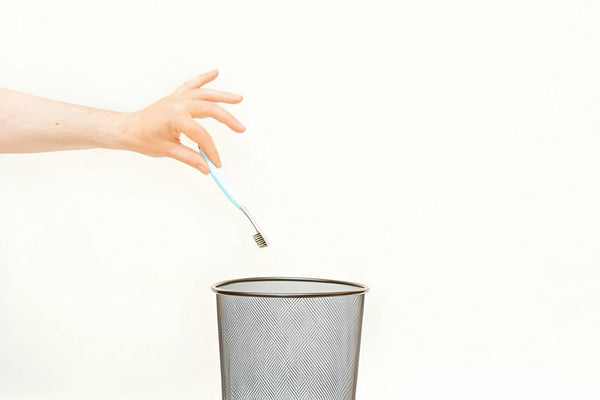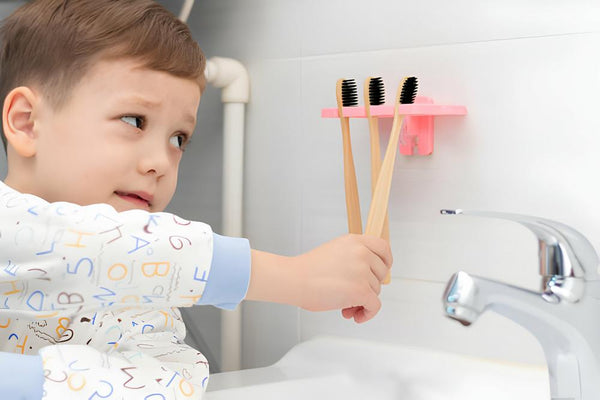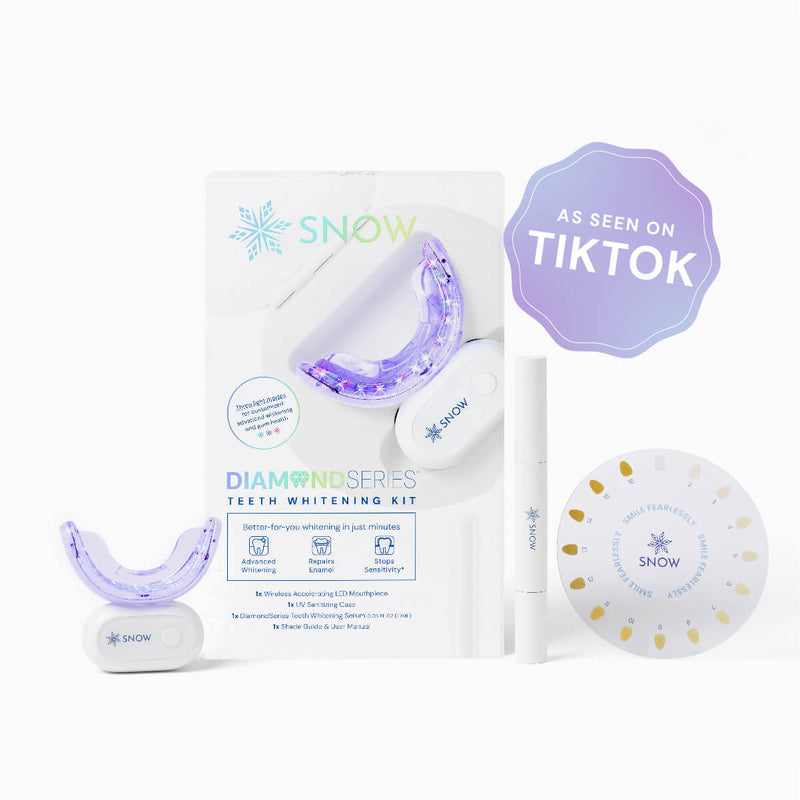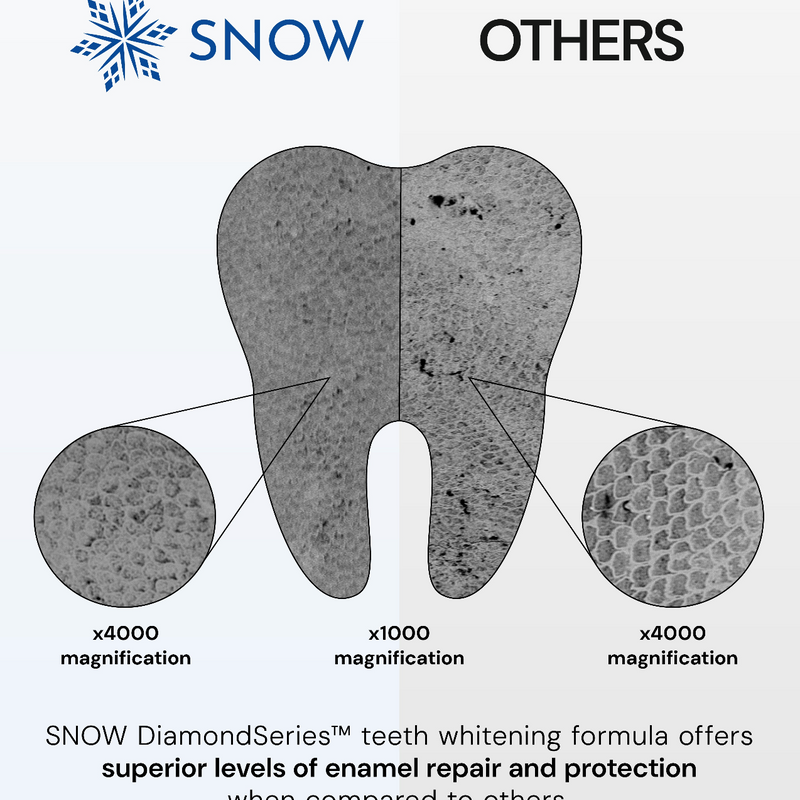How often should you change your toothbrush? At SNOW, we recommend replacing your toothbrush every three to four months for optimal dental health.
Now, let's dive into why this is crucial and what you can expect from this article.
We'll explore signs indicating it's time for a new toothbrush, potential consequences of neglecting to replace it, and specific recommendations for various types of toothbrushes, including manual and electric options.
Additionally, we'll provide tips on maintaining toothbrush heads to extend their lifespan and discuss the best practices for ensuring your toothbrush lasts longer.
By the end, you'll have a comprehensive understanding of toothbrush replacement frequency and how it impacts your oral hygiene routine.
What this article covers:- How Often Should You Change Toothbrushes?
- Why You Need to Get a New Toothbrush Regularly
- How Do Know When Your Toothbrush Needs to Be Replaced?
- What Can Happen If You Don't Switch Out Your Toothbrush Often Enough?
- How Often Should I Change My Manual Toothbrush?
- How Often Should I Change My Toothbrush with Braces?
- How to Maintain Your Toothbrush Heads
- What's the Best Kind of Toothbrush to Use?
- How to Make Your Toothbrush Last Longer
- Changing Your Toothbrush FAQs
How Often Should You Change Toothbrushes?
According to experts at WebMD, replacing your toothbrush every three to four months is essential for optimal dental health.
Why? Well, over time, the bristles on your toothbrush can become frayed and worn, making them less effective at removing plaque and debris from your teeth and gums.
But that's not the only reason. As your toothbrush ages, or if you notice your toothbrush turning pink, it can also become a breeding ground for bacteria, which can lead to oral health issues like gum disease and tooth decay.

Your toothbrush is a crucial tool for maintaining oral hygiene, but it's not meant to last forever.
By replacing your toothbrush regularly, you can help prevent the buildup of harmful bacteria and maintain a healthy mouth.
At SNOW, we understand the importance of good oral hygiene, which is why we offer a range of advanced whitening electric toothbrushes designed to keep your smile bright and your mouth healthy.
Check out our LED Teeth Whitening Electric Toothbrush and Advanced Whitening Electric Toothbrush to upgrade your dental care routine.
Why You Need to Get a New Toothbrush Regularly
Regular toothbrush replacement is essential for maintaining good oral hygiene. Over time, bristles become frayed and less effective at cleaning, while bacteria buildup can lead to oral health issues.
At SNOW, we emphasize the importance of regular toothbrush replacement for maintaining optimal oral hygiene. Over time, the bristles of your toothbrush can wear down, losing their effectiveness in removing plaque and debris from your teeth and gums.
This degradation can compromise your dental health and lead to issues like cavities and gum disease. Additionally, bacteria can accumulate on the surface of your toothbrush, increasing the risk of oral infections and decay.
Similarly, knowing when to change your toothbrush after strep is crucial, as bacteria from the illness can linger on the bristles, posing a health risk.
By replacing your toothbrush regularly, you ensure that you're using a tool that can effectively clean your teeth and gums, reducing the likelihood of oral health problems.
We offer a variety of toothbrush options, including our LED Teeth Whitening Electric Toothbrush, Bamboo Toothbrush, and Advanced Whitening Electric Toothbrush, designed to help you maintain a bright, healthy smile.

How Do Know When Your Toothbrush Needs to Be Replaced?
Regular toothbrush replacement is essential for maintaining good oral hygiene and effective teeth whitening. Frayed bristles, unpleasant odors, recent illnesses, and forgetting the last replacement date are all signs indicating the need for a new toothbrush.
Ensuring your toothbrush is in top condition is crucial for effective oral hygiene and teeth whitening. Some individuals also report that a new electric toothbrush feels weird at first, but this sensation usually indicates a more effective cleaning process.
Here are some signs that it's time to bid farewell to your old toothbrush:
The Bristles Are Frayed
As you brush, pay attention to the condition of the bristles. If they appear frayed, bent, or splayed, it's a clear indicator that your toothbrush needs replacing.
Frayed bristles are less effective at cleaning plaque and debris from your teeth, compromising your dental health.
According to WikiHow, maintaining clean and straight bristles is essential for optimal toothbrush performance.
It Has A Smell
A foul odor emanating from your toothbrush indicates bacterial buildup. Even with regular cleaning, bacteria can accumulate over time, leading to malodor.
To maintain fresh breath and oral health, promptly replace your toothbrush if it emits an unpleasant smell.
You Were Recently Sick
After recovering from an illness, it's imperative to replace your toothbrush to prevent the spread of germs. Bacteria from your sickness may linger on the bristles, increasing the risk of reinfection or spreading illness to others.
You Don't Remember When You Last Replaced It
If you can't recall the last time you changed your toothbrush, it's likely overdue for replacement.
Establish a routine to swap out your toothbrush every three to four months to ensure consistent oral hygiene and effective teeth whitening.
What Can Happen If You Don't Switch Out Your Toothbrush Often Enough?
Failure to replace your toothbrush regularly can result in decreased effectiveness, increased risk of dental issues, persistent bad breath, and gum irritation and infections.
Neglecting to replace your toothbrush regularly can lead to various negative consequences for your oral health:
- Decreased effectiveness: As toothbrushes age, their bristles wear down, reducing their ability to effectively remove plaque and bacteria from teeth.
- Increased risk of dental issues: With decreased effectiveness comes a higher risk of dental problems such as cavities and gum disease.
- Persistent bad breath: Inadequate plaque removal can lead to bad breath due to the accumulation of bacteria in the mouth.
- Gum irritation and infections: Worn-out toothbrushes can irritate the gums, potentially leading to inflammation and oral infections.
Regularly replacing your toothbrush is essential for maintaining optimal oral hygiene and preventing these issues.

How Often Should I Change My Manual Toothbrush?
For individuals using manual toothbrushes, it's recommended to replace them every three to four months.
However, it's essential to be vigilant for signs of wear and tear, as these can indicate the need for earlier replacement. Proper toothbrush maintenance is also crucial in extending its lifespan.
- Replace every 3-4 months: Regularly swapping out your manual toothbrush helps ensure optimal cleaning effectiveness.
- Monitor signs of wear and tear: Keep an eye out for frayed or bent bristles, which can indicate that your toothbrush is no longer effectively cleaning your teeth.
- Proper maintenance: Rinse your toothbrush thoroughly after each use and store it upright in an open-air environment to allow for proper drying, which can help prevent bacterial growth.
By adhering to these practices, you can ensure that your manual toothbrush remains effective and contributes to your at-home teeth whitening routine.
How Often Should I Change My Toothbrush with Braces?
For individuals with braces, maintaining oral hygiene is crucial due to the potential for food particles and bacteria to get trapped around the brackets and wires.
Therefore, it's recommended to replace your toothbrush more frequently compared to those without braces.
Aim to change your toothbrush every six to eight weeks to effectively prevent plaque buildup and maintain optimal oral health while undergoing orthodontic treatment.
This increased frequency helps ensure that your toothbrush remains effective in removing debris and bacteria from around the braces, reducing the risk of dental issues such as cavities and gum inflammation.
How To Maintain Your Toothbrush Heads
To ensure optimal performance and longevity of your toothbrush heads, it's essential to practice proper maintenance techniques.
After each use, thoroughly rinse your toothbrush heads under running water to remove any remaining toothpaste and debris.
Allow them to air dry upright in an open area to prevent moisture buildup, which can foster bacterial growth and mold.
Avoid storing toothbrush heads in closed containers or covering them, as this can trap moisture and promote the proliferation of bacteria.
Instead, opt for a toothbrush holder that allows for proper ventilation, ensuring that the bristles remain dry between uses.
Following these simple maintenance practices will help keep your toothbrush heads clean and hygienic, promoting better oral health and preventing potential oral infections.
What's the Best Kind of Toothbrush to Use?
Selecting the right toothbrush is crucial for maintaining oral hygiene and achieving a brighter smile. The best toothbrush varies based on individual needs and preferences. Both manual and electric toothbrushes offer effective cleaning when used correctly.
For manual toothbrushes: Our SNOW Bamboo Toothbrush stands out as an eco-friendly option. Crafted from sustainable bamboo, it features soft bristles that gently clean teeth and gums without causing irritation.
The ergonomic design ensures a comfortable grip, making brushing a pleasant experience.
For electric toothbrushes: We recommend the SNOW LED Teeth Whitening Electric Toothbrush. This innovative device combines the benefits of sonic technology with LED teeth whitening, providing thorough cleaning and professional-level whitening in one convenient tool.
With multiple brushing modes and a sleek design, it offers an advanced yet user-friendly experience.
Whether you prefer the simplicity of a manual toothbrush or the advanced features of an electric one, choosing the right toothbrush can enhance your oral care routine and contribute to a whiter, healthier smile.
How to Make Your Toothbrush Last Longer
Ensuring the longevity of your toothbrush is essential for maintaining optimal oral hygiene.
Here are some practical tips from SNOW to prolong the lifespan of your toothbrush:
- Rinse thoroughly: After each use, thoroughly rinse your toothbrush under running water to remove toothpaste residue and debris. This helps prevent bacterial growth and maintains brush cleanliness.
- Store it in an upright position: Store your toothbrush upright in a toothbrush holder or cup to allow proper air circulation and drying. Avoid covering the brush head or storing it in closed containers, as this can promote bacterial proliferation.
- Avoid sharing: Keep your toothbrush for personal use only and avoid sharing it with others. Sharing toothbrushes can lead to the transfer of bacteria and increase the risk of oral infections.
- Replace brush heads regularly: Install replacement brush heads every three to four months, or sooner if the bristles become frayed or worn out. This ensures effective cleaning and prevents bacterial buildup on old brushes [5].
By following these simple yet effective practices, you can extend the life of your toothbrush and maintain optimal oral health.

Changing Your Toothbrush FAQs
How often should I change my electric toothbrush heads?
Electric toothbrush heads should be replaced approximately every three months, similar to manual toothbrushes.
Some electric toothbrush models come with indicator bristles that fade over time, signaling when it's time for a replacement.
Follow the manufacturer's recommendations for optimal dental care.
How long do toothbrushes usually last?
On average, toothbrushes last between three and four months with regular use. However, factors such as bristle quality, brushing technique, and frequency of use can impact their lifespan.
Inspect your toothbrush regularly for signs of wear and replace it as needed to ensure optimal oral hygiene.
Conclusion
As we come to the end of our journey through the realm of toothbrush maintenance, it's evident that proper care is paramount for oral health.
By diligently rinsing your toothbrush after each use, storing it upright, and replacing it every few months, you ensure a clean and effective brushing experience.
Whether you opt for a manual or electric toothbrush, SNOW's bamboo and LED teeth whitening electric toothbrushes offer quality and durability.
Remember, your toothbrush plays a vital role in your dental routine, contributing to a brighter and healthier smile. So, why not enhance your oral care regimen with SNOW's innovative teeth whitening solutions?
Visit our website to explore our range of products and embark on your journey towards a radiant smile. Teeth whitening has never been easier with SNOW.
If you want to learn more, why not check out these related posts:
- Toothbrush Hurt My Gums
- Why Should You Change Your Toothbrush Every 3 Months
- Best Electric Toothbrush for Small Mouths
- Bamboo Toothbrush Benefits
- Tongue Scraper vs. Toothbrush
- Soft vs. Extra Soft Toothbrush
- Electric Toothbrush Round Head vs Oblong
- When to Change Toothbrush After Being Sick
- How to Clean Electric Toothbrush
- Does Electric Toothbrush Clean Better?
- Can Your Toothbrush Make You Sick?
- Cleaning Toothbrush with Vinegar
- How to Use Electric Toothbrush
- Benefits of Electric Toothbrush
- How Often to Replace Electric Toothbrush
























